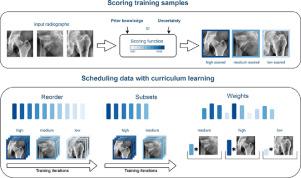Medical Image Analysis ( IF 10.7 ) Pub Date : 2021-10-21 , DOI: 10.1016/j.media.2021.102273 Amelia Jiménez-Sánchez 1 , Diana Mateus 2 , Sonja Kirchhoff 3 , Chlodwig Kirchhoff 4 , Peter Biberthaler 4 , Nassir Navab 5 , Miguel A González Ballester 6 , Gemma Piella 1

|
An adequate classification of proximal femur fractures from X-ray images is crucial for the treatment choice and the patients’ clinical outcome. We rely on the commonly used AO system, which describes a hierarchical knowledge tree classifying the images into types and subtypes according to the fracture’s location and complexity. In this paper, we propose a method for the automatic classification of proximal femur fractures into 3 and 7 AO classes based on a Convolutional Neural Network (CNN). As it is known, CNNs need large and representative datasets with reliable labels, which are hard to collect for the application at hand. In this paper, we design a curriculum learning (CL) approach that improves over the basic CNNs performance under such conditions. Our novel formulation reunites three curriculum strategies: individually weighting training samples, reordering the training set, and sampling subsets of data. The core of these strategies is a scoring function ranking the training samples. We define two novel scoring functions: one from domain-specific prior knowledge and an original self-paced uncertainty score. We perform experiments on a clinical dataset of proximal femur radiographs. The curriculum improves proximal femur fracture classification up to the performance of experienced trauma surgeons. The best curriculum method reorders the training set based on prior knowledge resulting into a classification improvement of 15%. Using the publicly available MNIST dataset, we further discuss and demonstrate the benefits of our unified CL formulation for three controlled and challenging digit recognition scenarios: with limited amounts of data, under class-imbalance, and in the presence of label noise. The code of our work is available at: https://github.com/ameliajimenez/curriculum-learning-prior-uncertainty.
中文翻译:

改进股骨骨折分类的课程学习:利用先验知识和不确定性调度数据
从 X 射线图像中对股骨近端骨折进行充分分类对于治疗选择和患者的临床结果至关重要。我们依赖常用的 AO 系统,它描述了一个分层知识树,根据骨折的位置和复杂性将图像分类为类型和子类型。在本文中,我们提出了一种基于卷积神经网络 (CNN) 将股骨近端骨折自动分类为 3 类和 7 类 AO 的方法。众所周知,CNN 需要具有可靠标签的大型且具有代表性的数据集,而这些数据集很难为手头的应用收集。在本文中,我们设计了一种课程学习(CL)方法,该方法在这种情况下提高了基本 CNN 的性能。我们的新颖配方重新统一了三种课程策略:对训练样本进行单独加权,对训练集进行重新排序,并对数据子集进行采样。这些策略的核心是对训练样本进行排序的评分函数。我们定义了两个新的评分函数:一个来自特定领域的先验知识和一个原始的自定进度的不确定性评分。我们对股骨近端 X 光片的临床数据集进行实验。该课程将股骨近端骨折分类提高到经验丰富的创伤外科医生的表现。最好的课程方法根据先验知识对训练集进行重新排序,从而将分类提高 15%。使用公开可用的 MNIST 数据集,我们进一步讨论并展示了我们的统一 CL 公式对三种受控且具有挑战性的数字识别场景的好处:数据量有限,在类不平衡和标签噪声存在的情况下。我们的工作代码可在以下网址获得:https://github.com/ameliajimenez/curriculum-learning-prior-uncertainty。











































 京公网安备 11010802027423号
京公网安备 11010802027423号